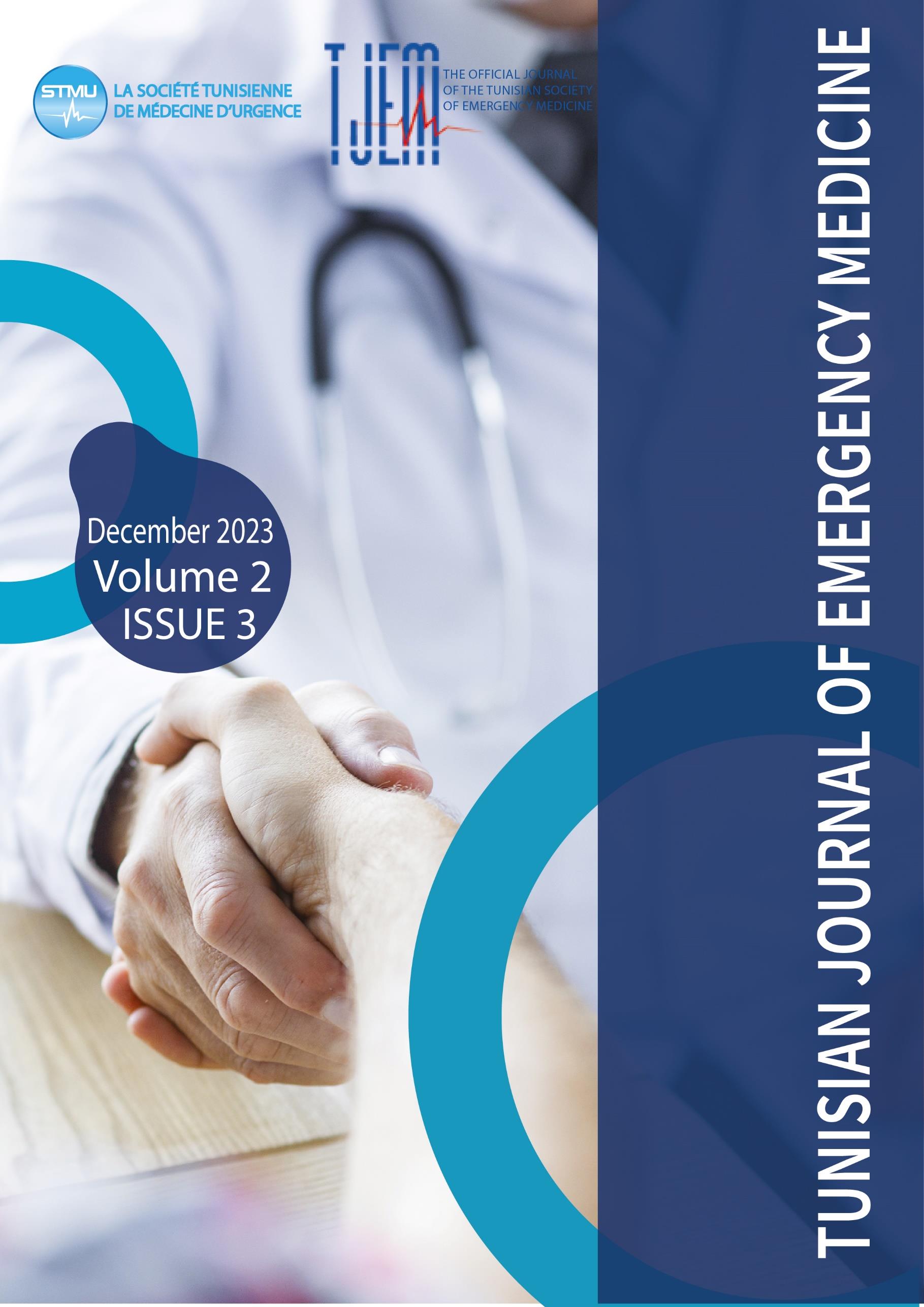Can we predict the clinical scenario of acute heart failure based only on NT proBNP rate without using echocardiography?
O. Djebbi 1, R. Jebri 1, H. Mahfoudhi 2, F. Aouini.2, M. Ben Abdellaziz.1, L. Lotfi.1, W. Fehri.2, K. Lamine 1.
DOI:
https://doi.org/10.0000/ghg6vs23Keywords:
Echocardiography, Emergency, heart failure, Natriuretic PeptidesAbstract
Background: The acute heart failure (AHF) is a common pattern to seek care in the emergency department (ED). The objective of our study was to investigate the relationship between NT pro-BNP and acute heart failure (AHF) syndrome in the emergency department (ED).
Methods: We conducted a descriptive prospective study over eight months. Were included all patients who presented to the emergency department (ED) with dyspnea and in whom the diagnosis of acute heart failure (AHF) was made. All patients had an NT pro-BNP laboratory test and underwent echocardiography.
Results: One hundred seven patients were included. Mean age was 65 ± 12 years. Sex ratio was 2.34. A clinical scenario CS1 was noted in 28% of cases, CS2 in 36% of cases, CS4 in 16% of cases, CS3 in 12% of cases and CS5 in 8% of cases. Thirty percent of patients had preserved left ventricular ejection fraction (LVEF) with diastolic dysfunction and 70% had a reduced left ventricular ejection fraction (LVEF). Elevated left ventricular filling pressures were found in 95% of patients. Disorders of wall motion in 14% of cases and isolated right heart failure in 12% of cases. The median natriuretic brain peptides (NT pro-BNP) level was higher when left ventricular ejection fraction (LVEF) was preserved: 4073 [410 – 25 550] pg/ml vs2025 [409 – 25 200] pg/ml (p=0,043).
Conclusion: Natriuretic brain peptides level was a good predictor of the clinical scenario CS1 with a cut-off at 5565 pg/ml. Though, the potential clinical applications of B-type natriuretic peptide in AHFS should be more studied.
Downloads
Published
Issue
Section
License
Copyright (c) 2023 Tunisian Journal of Emergency Medicine

This work is licensed under a Creative Commons Attribution-NonCommercial-ShareAlike 4.0 International License.
How to Cite
Similar Articles
- Marwa TOUMIA, Fatma Zaouali, Lamia Bouzgarrou, Guillain–Barré syndrome after an asymptomatic COVID‐19 Infection: a case report , Tunisian Journal of Emergency Medicine: Vol. 3 No. 1 (2025): TJEM 2025: Vol.3 Issue 1
- Faten DHOUIB, Aimen Dammak, Faiza Safi, Fatma MHIRI, zied CHAARI, Successful Conservative Management of Penetrating Cervical Tracheal Injury: A Case Report , Tunisian Journal of Emergency Medicine: Vol. 3 No. 1 (2025): TJEM 2025: Vol.3 Issue 1
- Neila MAAROUFI, Youssef Zouaghi, Khaoula Amdouni, Sabra Ouaz, Beligh Oueslati, Moufida Nouari, Beyond the Rash: The Fatal Consequences of Lyell Syndrome , Tunisian Journal of Emergency Medicine: Vol. 3 No. 2 (2025): TJEM 2025: Vol.3 Issue 2
- Rim Karray, Kais Ben Jeddou, Hana Ksentini, Leila Chaari, Adel Chaari, Noureddine Rekik, The Perthes syndrome: a case report , Tunisian Journal of Emergency Medicine: Vol. 3 No. 1 (2025): TJEM 2025: Vol.3 Issue 1
- Dr.Rania AMMAR ZAYANI, Dr.Sarra Temani, Dr. Mabrouk Bahloul, Dr.Chokri Ben Hamida, Pregabalin Toxicity-Induced Posterior Reversible Encephalopathy Syndrome , Tunisian Journal of Emergency Medicine: Vol. 3 No. 2 (2025): TJEM 2025: Vol.3 Issue 2
- Ikhlass BEN AICHA, Importance of Simulation in setting up ultrasoundguided vascular access , Tunisian Journal of Emergency Medicine: Vol. 2 No. 2 (2022): TJEM Vol2 Issue2
- Houda BEN SOLTANE, Neurologic manifestations of infective endocarditis , Tunisian Journal of Emergency Medicine: Vol. 2 No. 3 (2023): TJEM Vol2 Issue3
- Neila MAAROUFI, Firas Kessentini, Sabra Ouaz, Meriem Jemili, Moufida Nouari, Jihen Lakhal, Bilateral ptosis caused by midbrain hemorrhage: a case report , Tunisian Journal of Emergency Medicine: Vol. 3 No. 1 (2025): TJEM 2025: Vol.3 Issue 1
- Sondes laajimi, Asma Ben Cheikh, Haifa Bradai, Nabil Chebbi, Salem Mefteh, Sonia Chouchène, Naoufel Chebili , Dorra Loghmari , Rabeb Mbarek, The Long-Term Somatic and Psychological Impact of Post-COVID Experience on Infected Patients , Tunisian Journal of Emergency Medicine: Vol. 3 No. 2 (2025): TJEM 2025: Vol.3 Issue 2
- Mounir Hagui, Sonia Slimi, Riadh Allani, Civil-Military Collaboration for health emergency preparedness , Tunisian Journal of Emergency Medicine: Vol. 2 No. 4 (2024): TJEM Vol2 Issue4
You may also start an advanced similarity search for this article.
Most read articles by the same author(s)
- olfa DJEBBI, Acute cerebral insults in the emergency department: epidemiology and predictive factors of highly sensitive troponin level’s increase , Tunisian Journal of Emergency Medicine: Vol. 2 No. 3 (2023): TJEM Vol2 Issue3
- olfa djebbi, A dramatic course of COVID-19-associatedmeningoencephalitis without respiratoryinvolvement: a case report , Tunisian Journal of Emergency Medicine: Vol. 2 No. 4 (2024): TJEM Vol2 Issue4

